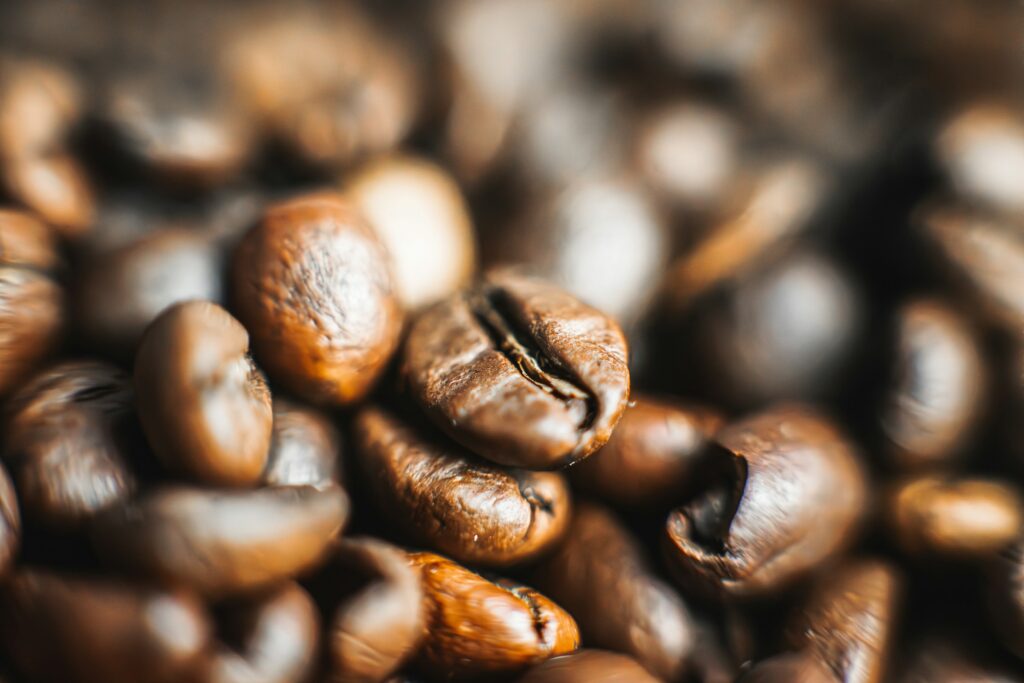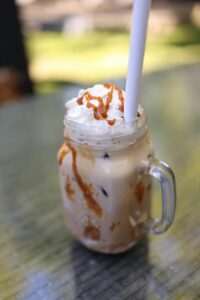Some coffee lovers swear by Arabica. Others won’t touch anything but Robusta. But here’s the thing—your choice of bean shapes everything from flavor to caffeine kick.
Arabica is smooth and sweet, often with hints of fruit or chocolate. Robusta, on the other hand, is bold, bitter, and packs nearly double the caffeine.
So, which one deserves a spot in your cup? Let’s break down the differences and help you choose the bean that matches your taste, budget, and lifestyle.
| Feature | Arabica ☕ | Robusta ⚡ |
|---|---|---|
| Flavor | Smooth, sweet, fruity, often acidic | Bold, bitter, earthy, nutty |
| Caffeine | Lower (gentler buzz) | Nearly double (strong punch) |
| Growing Needs | Higher altitudes, cooler climates, delicate | More antioxidants, easier on the stomach |
| Price | More expensive | More affordable |
| Best In | Specialty brews, pour-overs, lattes | Espresso blends, instant coffee, budget brews |
| Health Notes | More antioxidants, easier on stomach | Strong antibacterial effects, harsher on digestion |
What Are Arabica and Robusta?
Arabica: The Delicate Favorite
Arabica beans come from the plant Coffea arabica. They’re often called the “premium” bean, and for good reason.
Arabica beans usually offer smoother, sweeter flavors with notes of fruit, berries, or chocolate. They’re also lower in caffeine, which makes them gentler on the stomach and less likely to give you the jitters.
The catch? Arabica plants are fussy. They need high altitudes, cooler climates, and careful farming. This makes them more expensive, but many coffee drinkers see the extra cost as worth it for the taste.
Robusta: The Strong Survivor
Robusta beans come from the plant Coffea canephora. If Arabica is a sensitive artist, Robusta is the tough soldier.
It thrives in hotter climates, lower altitudes and doesn’t need as much pampering to grow. Robusta beans have a bold, bitter flavor—sometimes earthy, nutty, or even woody.
They also contain almost twice the caffeine of Arabica. That extra caffeine acts like natural bug spray, keeping pests away and making Robusta easier (and cheaper) to cultivate.
This is why you’ll often see Robusta used in instant coffee, budget blends, or to add extra “kick” to espresso.
Origins and Growing Regions
Arabica originally comes from the highlands of Ethiopia and is now grown in places like Latin America, East Africa, and parts of Asia. Countries like Colombia and Ethiopia are famous for their Arabica beans.
Robusta, on the other hand, traces its roots to sub-Saharan Africa. Today, it’s mostly grown in Vietnam, Indonesia, and parts of Africa.
In fact, Vietnam is one of the biggest producers of Robusta coffee in the world. The geography matters: where the bean grows shapes its taste, quality, and price.
Flavor Profile Comparison
Arabica: Smooth and Subtle
Arabica beans are the go-to choice if you enjoy coffee that feels more like a treat than a wake-up slap. Their flavor is smooth, often sweet, and sometimes layered with fruity or chocolatey notes.
Depending on where they’re grown, you might taste hints of berries, citrus, or even flowers.
Arabica is also known for its acidity—not the kind that burns your tongue, but a bright, tangy sharpness that makes the flavor pop.
This is why Arabica often shows up in pour-over brews, single-origin coffees, and light roasts where drinkers want to savor every nuanced sip.
Robusta: Strong and Stubborn
Robusta takes a completely different approach. It doesn’t whisper flavor—it shouts it. Expect bold, earthy, and sometimes bitter notes. Many describe it as nutty, woody, or even a little smoky.
With nearly double the caffeine of Arabica, Robusta brings both strength and bite. That bitterness can feel overpowering to some, but it shines in the right drinks.
Robusta adds body and a strong crema to espresso, making it a favorite in traditional Italian blends. It’s also the backbone of many instant coffees because of its intensity and affordability.
Best Uses in Your Cup
If you love sipping slowly and picking out subtle flavors, Arabica is your bean. Think lattes, cappuccinos, or a carefully brewed pour-over that highlights its delicate sweetness.
Robusta, on the other hand, is perfect when you want a coffee that kicks down the door. It thrives in espresso shots, dark roasts, or blends designed for strength.
Some roasters even mix Arabica and Robusta together to balance Arabica’s smooth elegance with Robusta’s raw power—like pairing fine wine with a shot of whiskey!
Caffeine Content and Kick
Arabica: A Softer Wake-Up Call
Arabica beans have less caffeine than their Robusta cousins—about half as much on average. That means the buzz you get is gentler, slower, and less likely to send your heart racing.
Many people find Arabica easier on the stomach and nerves, especially if they’re sensitive to caffeine.
It’s the kind of coffee you can sip during a relaxed morning or late afternoon without fearing the dreaded “caffeine crash” later.
Think of Arabica as the friendly nudge rather than the blaring alarm clock.
Robusta: Double the Caffeine, Double the Punch
Robusta beans pack a serious wallop. With nearly twice the caffeine of Arabica, a cup of Robusta coffee feels like flipping a light switch on your brain.
That extra caffeine also gives Robusta its naturally bitter edge and thicker body. It’s perfect for people who want a strong morning kick, stay alert during long shifts, or power through study sessions.
But beware, because if you’re not used to it, Robusta can feel like a double espresso to the face.
Choosing the Right Kick for You
If you’re sensitive to caffeine, prone to jitters, or simply enjoy multiple cups a day, Arabica is probably your best bet. It’s smoother, softer, and won’t keep you up all night after an afternoon brew.
If you need an energy boost that rivals an energy drink or like your coffee bold and bracing, Robusta will deliver.
And if you’re torn between the two? Many blends combine Arabica’s flavor with Robusta’s power, giving you the best of both worlds in one cup.
Growing Conditions and Farming
Arabica: The Picky Guest
Arabica beans are like that friend who insists on the perfect room temperature and the right playlist before they’re comfortable.
They need higher altitudes—usually between 2,000 and 6,000 feet—and cooler climates to thrive. Places like Colombia, Ethiopia, and Costa Rica fit the bill perfectly. But Arabica plants are fragile.
They’re prone to diseases like coffee leaf rust, they hate too much heat, and they demand careful farming.
Robusta: The Tough Survivor
Robusta plants couldn’t be more different. They don’t need the luxury treatment. Instead, they thrive in lower altitudes, hotter climates, and less predictable weather.
That’s why countries like Vietnam, Uganda, and Indonesia produce huge amounts of Robusta.
These plants are naturally more resistant to pests and disease, thanks to their high caffeine levels acting as a built-in bug repellent.
Farmers love them because they’re easier to grow and more reliable. This resilience makes Robusta cheaper and more widely available.
How Farming Shapes Your Cup
These growing conditions directly affect both flavor and price. Arabica’s delicate environment results in more complex, nuanced flavors, but that also makes it a premium product.
Robusta’s rugged resilience produces a stronger, less refined taste but keeps it affordable.
In other words, when you pay more for Arabica, you’re not just paying for the taste, but you’re also covering the “spa treatment” it needs to grow.
Robusta, on the other hand, is like the no-nonsense workhorse that shows up rain or shine.
Price and Market Value
Arabica: The Premium Pick
Arabica beans usually come with a higher price tag. The reason isn’t just marketing—it’s farming reality. Arabica is harder to grow, more vulnerable to pests, and needs an ideal climate.
Add in the fact that demand is sky-high thanks to its smoother, more complex flavor, and you’ve got a bean that costs more per pound.
When you’re buying single-origin coffees or specialty café brews, you’re often paying extra for Arabica’s delicate nature and the care that goes into producing it.
Robusta: The Budget-Friendly Workhorse
Robusta, on the other hand, is the wallet-friendly option. Because it grows more easily and yields more beans per plant, it’s cheaper to produce.
That’s why you’ll often see Robusta in instant coffee, supermarket blends, and espresso mixes where strength and price matter more than subtle flavor notes.
It may not have the prestige of Arabica, but it offers serious value, especially if you just need a strong cup to wake up without draining your bank account.
Price at the Consumer Level
For the average coffee drinker, price plays a big role in what ends up in the cup. If you’re splurging at a café, chances are you’re drinking Arabica.
If you’re stocking up on bulk instant coffee or budget-friendly espresso blends, Robusta is probably involved. Some blends even mix the two, letting roasters balance flavor with affordability.
At the end of the day, your choice often comes down to whether you want coffee to be an experience or simply an affordable daily ritual.
Health Benefits and Considerations
Arabica: Gentle on the System
Arabica beans carry a solid dose of antioxidants, which help fight cell damage and support overall health.
Because they have less caffeine, they’re easier on the nervous system and less likely to cause jitters or anxiety.
Many people with sensitive stomachs also find Arabica more forgiving since its lower caffeine and smoother flavor reduce the risk of acid-related discomfort.
It’s the kind of coffee that lets you enjoy multiple cups without feeling like you’ve run a marathon inside your own head.
Robusta: Power in Every Sip
Robusta’s higher caffeine content isn’t just about the buzz—it also brings antibacterial properties. Studies suggest that caffeine can help fight certain bacteria, giving Robusta an edge in this area.
The stronger punch of caffeine may also improve alertness and focus, making it appealing for people who need to stay sharp. But there’s a trade-off.
That extra caffeine can be tough on sensitive stomachs, sometimes leading to acid reflux or digestive upset.
Add its naturally harsher taste, and it’s not always the easiest bean for daily, heavy consumption.
Finding What Works for You
Health-wise, the choice often comes down to your personal tolerance. If you’re prone to caffeine crashes, jitters, or stomach sensitivity, Arabica is the safer bet.
If you’re chasing sharper focus or want a stronger antibacterial boost, Robusta delivers. Some blends even combine the two, giving you a balance of antioxidants, flavor, and kick.
Which One Should You Choose?
For Flavor Seekers: Arabica
If your idea of coffee is more about savoring than surviving, Arabica is your match. Its smooth, sweet, and fruity notes make it the bean of choice for people who love coffee as an experience.
It’s perfect for slow mornings, café-style drinks, or anyone who likes to notice the little details in each sip. Arabica is the bean that makes you stop mid-conversation just to say, “Wow, this tastes good.”
For Energy and Affordability: Robusta
Need your coffee to double as rocket fuel? Robusta has your back. With nearly twice the caffeine, it’s the go-to for people who want a strong, bold cup without overthinking flavor notes.
It’s also easier on the wallet, which makes it ideal for students, shift workers, or anyone who sees coffee as a daily necessity rather than a luxury.
For Balance: Blends
Sometimes, you don’t have to pick sides. Many roasters mix Arabica and Robusta together to get the best of both worlds.
The Arabica adds sweetness and complexity, while the Robusta brings strength, crema, and kick.
Blends are especially common in espresso, where the balance between smoothness and punch makes all the difference.
Matching Coffee to Your Lifestyle
At the end of the day, the “best” bean depends on you. Do you want coffee to be a mindful ritual, a quick pick-me-up, or a mix of both?
Arabica, Robusta, or a blend can all fit the bill depending on your mood, budget, and goals. The fun part? You don’t have to commit forever.
Try them side by side, experiment with blends, and let your taste buds cast the final vote.
Final Words
Arabica gives you smooth sweetness and subtle flavors, while Robusta delivers bold strength and a serious caffeine jolt. One is pricier and refined, the other affordable and powerful.
But here’s the truth—neither is better for everyone. The right choice depends on your taste buds, your budget, and how much of a caffeine kick you’re chasing.
So don’t just read about it. Brew a cup of each, taste them side by side, and let your palate decide which bean truly belongs in your daily ritual!
FAQs
Is Arabica healthier than Robusta?
Not necessarily because it depends on what you’re looking for. Arabica has more antioxidants and less caffeine, which makes it easier on sensitive stomachs.
Robusta has higher caffeine and stronger antibacterial properties. Both bring unique health perks.
Why is Arabica more expensive?
Arabica is harder to grow, more vulnerable to pests, and needs cooler, higher-altitude climates. Add in its global demand for smoother flavor, and the price naturally climbs higher than Robusta.
Can I mix Arabica and Robusta beans?
Absolutely. Many roasters blend the two to balance flavor and strength. Arabica adds sweetness and complexity, while Robusta gives body, crema, and caffeine kick—especially in espresso blends.
Which one is better for espresso?
It depends on your preference. Pure Arabica gives you a smooth, refined espresso. Robusta creates a thicker crema and a stronger punch. Many espresso blends combine both for the best of each.
Does Starbucks use Arabica or Robusta?
Starbucks uses 100% Arabica beans. They focus on the smoother, more complex flavors Arabica offers, which align with their global brand and specialty coffee positioning.



